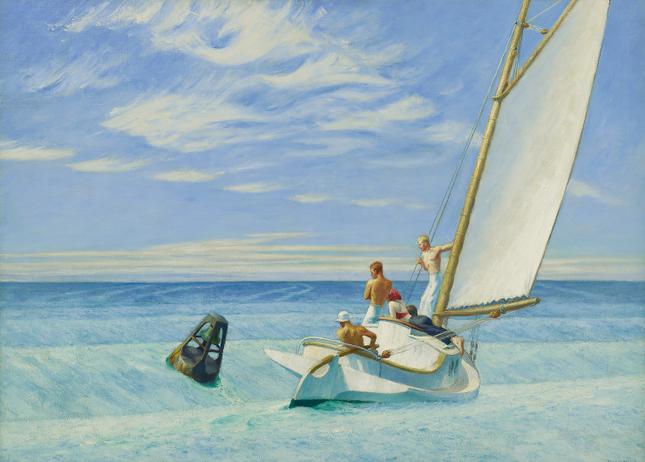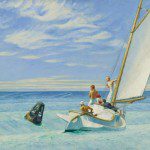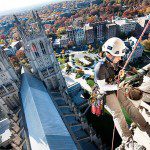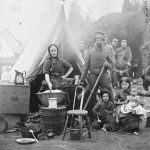New Exhibitions at D.C. Museums
By • March 11, 2015 0 1176

Smithsonian Anacostia Community Museum
“How the Civil War Changed Washington”?
Feb. 2 – Nov. 15
This exhibition examines the social and spatial impact on Washington, D.C., of the Civil War, an era of radical population growth. The growth in the African American population continued until, a century later, African Americans became the majority in the District. This was also a time when women joined the federal workforce and neighborhoods were built out of the hilly terrain, expanding the city’s footprint. The exhibition contextualizes these and other changes while telling the stories of individuals who came to Washington during the Civil War.
National Building Museum
“Scaling Washington: Photographs by Colin Winterbottom”
Opens March 21
Over 20 years ago, photographer Colin Winterbottom began taking dramatic, highly textured photographs of Washington, D.C.’s many architectural masterpieces. Always determined to create imagery unlike any he’d seen before, he quickly recognized the power of scaffolding to provide up-close – and high-altitude – access to these historic structures. As sole photographer for restoration efforts at the Washington Monument and National Cathedral following the August 2011 earthquake, Winterbottom blends documentation with artistic expression, crafting photographs that share his unusual access to remarkable vantage points.
National Museum of African Art
“The Divine Comedy: Heaven, Purgatory, and Hell Revisited by Contemporary African Artists”
April 8 – Aug. 2
Curated by the internationally acclaimed writer and art critic Simon Njami, this dramatic multimedia exhibition reveals the ongoing global relevance of Dante Alighieri’s 14th-century epic as part of a shared intellectual heritage. Including original commissions and renowned works of art by approximately 40 of the most dynamic contemporary artists from 19 African nations and the diaspora, this visually stunning exhibition will explore the themes of paradise, purgatory and hell with video, photography, printmaking, painting, sculpture, fiber arts and mixed media installation.
National Portrait Gallery??
“Elaine de Kooning: Portraits”
March 13 – Jan. 10?
Elaine de Kooning’s gestural portraits of friends and family were much admired during her lifetime, and included such well-known Americans as poets Frank O’Hara and Allen Ginsberg, critic Harold Rosenberg, choreographer Merce Cunningham and painters Willem de Kooning (her husband) and Fairfield Porter. De Kooning made both abstract and figurative paintings and drawings during the height of Abstract Expressionism in New York City. In her portraits, de Kooning sought and worked to capture the “instantaneous illumination” of recognition.
Smithsonian American Art Museum??
“Mingering Mike’s Supersonic Greatest Hits”
Feb. 27 – Aug. 2?
In 2013, the Smithsonian American Art Museum acquired a collection of artwork made between 1969 and 1976 by a self-taught local artist known only by his alter ego, Mingering Mike. This exhibition comprises artworks constructed as part of his youthful fantasy of becoming a famous soul singer and songwriter, including LP albums made from painted cardboard, original album art, song lyrics, liner notes and self-recorded 45 rpm singles. The works are a window into a historical moment when black radio was new and Washington-based performers such as Marvin Gaye were gaining national attention and transforming American music.
“The Artistic Journey of Yasuo Kuniyoshi”?
April 3 – Aug. 30?
This exhibition is the first overview of Yasuo Kuniyoshi’s work in more than twenty-five years. Born in Japan, Kuniyoshi (1893-1953) came to the United States as a teenager. He came into prominence during the 1920s through his distinctive modern figural style, original subjects and humor. Classified an “enemy alien” after the bombing of Pearl Harbor, he worked with the Office of War Information to create artworks indicting Japanese atrocities. After the war, Kuniyoshi developed a compelling late style, with bitter subjects and paradoxically bright colors.
National Gallery of Art
“Piero di Cosimo: The Poetry of Painting in Renaissance Florence”
Feb. 1 – May 3
A contemporary of Botticelli, da Vinci and Michelangelo, Piero di Cosimo was known in his day for his versatility as a painter of many different subjects, from the sacred to the profane, the latter often of beguiling meaning. His fantastic inventions rivaled the verses of the ancient poets whose myths and allegories he set out to transform in a wonderfully strange language all his own. The first major retrospective exhibition of paintings by this wildly imaginative Italian Renaissance master features 44 of the artist’s most compelling paintings, including fanciful mythologies, powerful religious works (one on loan for the first time from the church in Italy for which it was created 500 years ago) and sensitive portraits.
“American Masterworks from the Corcoran, 1815-1940”
Feb. 7 – May 3
In 2014, the National Gallery assumed stewardship of over 6,000 works of art from the Corcoran Gallery of Art’s renowned collection. Thankfully, they have wasted no time in getting that work back out to the public. Two installations featuring highlights from the Corcoran collection are now on view in the West Building, including such celebrated paintings as Frederic Edwin Church’s “Niagara,” Albert Bierstadt’s “The Last of the Buffalo,” Sanford Robinson Gifford’s “Ruins of the Parthenon,” Samuel F. B. Morse’s “The House of Representatives” and Edward Hopper’s “Ground Swell.” And of course there is Frederic Remington’s bronze sculpture of a lively depiction of cowboy revelry – for what American collection is complete without that?
Freer and Sackler Galleries
“Seasonal Landscapes in Japanese Screens”
March 7 – Sept. 6?
Cherry trees bloom in this selection of folding screen paintings from the Freer Gallery. These landscapes from the 16th and early 17th centuries combine ink painting techniques assimilated from China with the vibrant color and gold of traditional Japanese paintings.??
Art Museum of the Americas??
“Libertad de Expresión: The Art Museum of the Americas and Cold War Politics”?
Feb. 19 – June 7?
Drawing from the Museum’s permanent collection, this exhibition surveys the taste and cultural diplomacy of founding director José Gómez Sicre, featuring artists who have worked in many of the influential styles at mid-century – Surrealism, Concretism, Art Informel and Abstract Expressionism – and who also experimented with forms and themes drawn from Pre-Columbian civilizations. Sicre lauded the diversity of expressions in Latin American art. This support also allied him with U.S. Cold Warriors, who used freedom of expression as a tool in the cultural and intellectual struggle against the Soviets.
- Edward Hopper, “Ground Swell,” 1939, oil on canvas, Corcoran Collection (Museum purchase, William A. Clark Fund). | Courtesy of the National Gallery of Art.




